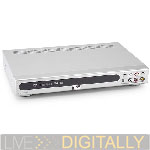
Introduction
My Panasonic VCR died a few months back, and I went to the store to replace it. After going up and down the aisles in more than one electronics giant, I came to the conclusion that the VCR was rapidly headed for extinction. The last remaining VCR’s were being sold for cheap in a corner. Soon the VCR will join the ranks of 8 tracks, records, and cassettes. In our new digital world, the analog VCR just doesn’t cut it anymore.
Truthfully, I liked the VCR very much. It was affordable, and the tapes were as well. Each tape could be used probably 100 times, more than I seem to get out of my rewritable optical media. My VCR was a 4 head model with HiFi stereo sound. On my 20” TV, through a stereo system, I could hardly tell that a DVD movie was any better than a prerecorded VCR tape.
But alas, while I lament my dead VCR, it was time to move on. My “wish list” for the new digital recorder included a large hard drive, fast DVD burner which is compatible with every disc, and a built in TV Guide (with no monthly fee). While such machines are coming on the market now, their caviar (over $500) price tag simply didn’t fit with my Cheeto’s ($100) budget. Also, I hesitated to spend “the big bucks” when the new HDTV standard is planned to replace our current TV signals in March 2006, and am unsure of future compatibility of all these devices. However, the new fall season of shows is imminent, with the need for time shifting, so I decided to take the digital plunge. The allure of being able to record to a disc that I could watch on a DVD player, or with the DVD drive of my computer was very strong.
Here at Live Digitally we have experience in reviewing computer DVDRW drives. This is the first set top DVD Recorder we’ve looked at, but we’ll subject it to the same rigorous standards, including media compatibility, and quality scanning. Set top DVD recorders are predicted to be very popular for the 2005 Holiday Shopping Season.
Entering the World of Set Top DVD Recording, Take 1
I first brought home an Emerson DVDR04 which features a VCR and a DVD recorder in one. The VCR actually worked quite well, but I had some problems with the DVD recorder. Due to my busy schedule and many product reviews this summer, I didn’t get a chance to write a dedicated review for this unit. In summary, I had three major issues with this recorder.
First, the drive is supposed to be able to dub between the VCR and the DVD drives. For example, if you have a DVD video that you have to return to Blockbuster, you could put it on a VCR tape so you could see the end (during which you might have “rested your eyes” aka: fell asleep) at a later date. However, due to copyright restrictions, the Emerson machine would not do this. Why list it as a feature, if every disc is copyright protected? While I won’t get into the legality of this, there are plenty of other machines out there that will accomplish this backup. Also, if I was watching a DVD, the VCR could not record, and also vice-versa. My older Sylvania DVD/VCR can play a DVD and record to videotape simultaneously. The new Emerson is a step back in features compared with my older Sylvania combo deck.
The next issue bothered me even more. The unit is listed as compatible with DVD-R and DVD-RW discs. The “plus” discs are certainly a lot popular than the “minus” ones, but I figured that after I buy a package or two of the DVD-RW discs, I’d be all set anyway, and who cares about “the format wars.” I purchased a package of TDK 4x DVD-RW discs from Microcenter. They have a whole long aisle of media, and the TDK’s and Memorex were the only two brands in the DVD-RW flavor for sale. The Emerson would not recognize the discs. I called the Emerson company, and spoke to service that sent me a firmware upgrade disc. Over a week later, my disc arrived from across the country. After a lengthy process, that involved the tech talking me through each step, I was firmware upgraded, supposedly able to use 8x DVD-R and 4x DVD-RW discs (currently 16x DVD-R and 6x DVD-RW discs are available). The Emerson still did not recognize the discs. After some late night forum searching, I figured out that even with the firmware upgrade, the unit will not work with 4x DVD-RW discs, only 2x. These older discs are not available locally, but could be found in a few places online at a premium for the older discs. I could not justify using a new DVD-R write once disc for every TV show I wanted to watch (4 hrs/DVD-R). Also, if on my brand new unit I’m having this much trouble finding appropriate media, what will happen in a year or two down the road?
The Emerson unit was supposed to feature an auto clock set feature. This is great because it means the unit will always have the right time, and you’ll never miss the beginning of a recording because the clock was off. I have a Sylvania combo deck without this feature that gains about a minute every month. The Emerson was not able to set itself, even after leaving the tuner on our public television station, as directed in the manual. In short, strike number three- you’re out!
After all this hassle and research, the unit was repackaged, and returned to Wally Mart. Thank heavens for their 90 day policy, and no restocking fee. For the record, the Emerson did record to Maxell 4x DVD-R disc on the 4 hour speed with acceptable quality on playback. While I got my money back, it was back to square one.
If at first you don’t succeed…
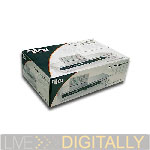 I decided to buy a machine that used the more popular DVD+R and DVD+RW “plus” discs of the DVD Alliance. After further research, I settled on the Ilo DVDR05 which is made by the Cyberhome Company. They are not generally that highly regarded as a company, but their products are very affordable (translation: almost disposable).
I decided to buy a machine that used the more popular DVD+R and DVD+RW “plus” discs of the DVD Alliance. After further research, I settled on the Ilo DVDR05 which is made by the Cyberhome Company. They are not generally that highly regarded as a company, but their products are very affordable (translation: almost disposable).
Opening the box…

The retail package of the Ilo DVDR05 includes the following:
– Ilo DVDR05 DVD recorder
– Coaxial cable
– RCA cable for stereo left, right and video
– Remote control with battery installed
– Owner’s manual
– Power cord
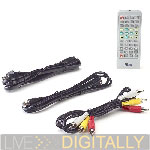 I noticed right away that the DVD recording unit itself is kind of small, and is smaller (16.9”) than the standard stereo rack size (17.5”) that most DVD recorders fit, and weighs only 4 pounds, 9 ounces. The Ilo is constructed out of sheet metal, and is painted a metallic silver.
I noticed right away that the DVD recording unit itself is kind of small, and is smaller (16.9”) than the standard stereo rack size (17.5”) that most DVD recorders fit, and weighs only 4 pounds, 9 ounces. The Ilo is constructed out of sheet metal, and is painted a metallic silver.
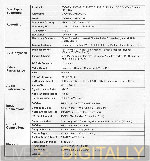 In terms of the specs, the machine can hold its own. It can play back DVD Videos, DVD+R, DVD+RW, DVD-R, DVD-RW, audio CD’s, CDR’s, CDRW’s, as well as video and super video CD’s. That’s already more than most DVD players available. The Ilo will also playback MP3’s (which many machines do), and WMA’s and JPG’s (which only a few machines do). Supporting both MP3’s and WMA’s is great. Being able to watch JPG photos from the couch, using the remote, is an awesome way digital vacation photos can be enjoyed by a group. I would like to see more DVD player/recorders able to playback picture files.
In terms of the specs, the machine can hold its own. It can play back DVD Videos, DVD+R, DVD+RW, DVD-R, DVD-RW, audio CD’s, CDR’s, CDRW’s, as well as video and super video CD’s. That’s already more than most DVD players available. The Ilo will also playback MP3’s (which many machines do), and WMA’s and JPG’s (which only a few machines do). Supporting both MP3’s and WMA’s is great. Being able to watch JPG photos from the couch, using the remote, is an awesome way digital vacation photos can be enjoyed by a group. I would like to see more DVD player/recorders able to playback picture files.
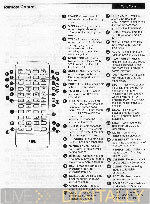 The remote is kind of small, with even smaller buttons. It runs off of a single large watch battery. While one is included, I can’t imagine it’s going to last too long, and will be more expensive than the AA or AAA cells that most other remotes are powered by. The small buttons are all lined up, and this makes it difficult in the dark to know which button to press. Actually, unless you have a photographic memory, it’s actually impossible to know which button to press. At least they should have made the “play” and “menu” buttons larger and more obvious. I keep my Maglite next to the remote for using it with the lights dimmed. A better laid out remote with larger buttons would be on my “wish list.”
The remote is kind of small, with even smaller buttons. It runs off of a single large watch battery. While one is included, I can’t imagine it’s going to last too long, and will be more expensive than the AA or AAA cells that most other remotes are powered by. The small buttons are all lined up, and this makes it difficult in the dark to know which button to press. Actually, unless you have a photographic memory, it’s actually impossible to know which button to press. At least they should have made the “play” and “menu” buttons larger and more obvious. I keep my Maglite next to the remote for using it with the lights dimmed. A better laid out remote with larger buttons would be on my “wish list.”

Connecting the wires…
Eager to hook things up, I plugged the coaxial cable from the roof top antenna into the Ilo, and the coaxial out into the television. This is exactly how I set the Emerson unit up. (Yes, I’m one of the estimated 40% of Americans who get my TV signal “over the air,” I think of it as the “original wireless”). With the Ilo powered on, I couldn’t find it on the TV on any channel. Upon reading the manual (always a last resort), I realized that I needed to plug the RCA plugs (video, L/R stereo) from the Ilo to the TV. This is unfortunate, as I was planning to keep my DVD player hooked up as well. This way I could record a TV program with the Ilo, and watch a DVD movie on the DVD player at the same time. The issue is my TV, from the early 90’s, only has one set of RCA inputs. Therefore, the Ilo is hogging both my coaxial input, and my RCA inputs. For the last several years, I have hooked up two different devices to my TV via different inputs, now I can’t due to the Ilo’s grabby behavior. Currently, with my DVD player thrown to the sidelines, at least the Ilo worked with the TV, and I got the start up screen when the video input was selected.
 For users with more modern TV sets, the outputs include the 1 wire “composite video output,” an S-video output, and a 3 wire component video output to handle the video needs. Supposedly, the component video output is best for TV’s that support progressive scanning, which the Ilo is capable of. I noticed no difference in the picture compared to my non-progressive output Sharp DVD player. The audio output is limited to RCA stereo left and right outputs, and digital. This means you can put your optical cable away as the Ilo is not designed to work with it. For the testing, I had my Ilo directly connected to a 200 watt Kenwood stereo unit with 2 speakers.
For users with more modern TV sets, the outputs include the 1 wire “composite video output,” an S-video output, and a 3 wire component video output to handle the video needs. Supposedly, the component video output is best for TV’s that support progressive scanning, which the Ilo is capable of. I noticed no difference in the picture compared to my non-progressive output Sharp DVD player. The audio output is limited to RCA stereo left and right outputs, and digital. This means you can put your optical cable away as the Ilo is not designed to work with it. For the testing, I had my Ilo directly connected to a 200 watt Kenwood stereo unit with 2 speakers.
Seeing the features…
 The digital clock on the unit immediately displayed the nearly correct time. This was a pleasant surprise after the Emerson failed to ever sync up with the time. While the time appeared accurate, it was not a total success. I later figured out that it was 12 hours off (AM not PM), and the date was off by a day. Maybe the signal it got sent was wrong? I’m still puzzled on this point on this feature. After setup, the clock did maintain the correct time and date which is better than a lot of other items I’ve owned. When the Ilo was unplugged, and tried again, the date was correct, but the time was two minutes off- I think it’s the signal being sent to it. I had to manually override it to get the correct time.
The digital clock on the unit immediately displayed the nearly correct time. This was a pleasant surprise after the Emerson failed to ever sync up with the time. While the time appeared accurate, it was not a total success. I later figured out that it was 12 hours off (AM not PM), and the date was off by a day. Maybe the signal it got sent was wrong? I’m still puzzled on this point on this feature. After setup, the clock did maintain the correct time and date which is better than a lot of other items I’ve owned. When the Ilo was unplugged, and tried again, the date was correct, but the time was two minutes off- I think it’s the signal being sent to it. I had to manually override it to get the correct time.
 The Ilo features on the front an additional set of analog RCA inputs, and a 4 pin FireWire input. This serves to allow an analog, or a digital camcorder to play its video into the Ilo to be saved onto a DVD. I don’t have a camcorder (yet) so I can’t test this feature further, however, this is an ideal way to distribute your video to far flung relatives with minimal cost and pain on recordable DVD’s.
The Ilo features on the front an additional set of analog RCA inputs, and a 4 pin FireWire input. This serves to allow an analog, or a digital camcorder to play its video into the Ilo to be saved onto a DVD. I don’t have a camcorder (yet) so I can’t test this feature further, however, this is an ideal way to distribute your video to far flung relatives with minimal cost and pain on recordable DVD’s.
Getting the discs to work…
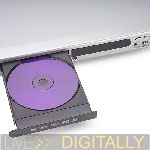 I was eager to get the Ilo burning, so I got out my collection of media. Neither a Ritek 8x DVD+RW or a Verbatim 8x DVD+RW could be formatted by the Ilo. Both rewritable discs have worked fine in multiple computer DVD writers so I knew the discs were not faulty. A Ritek 8x DVD+R disc was able to be used with the recorder. It was pretty obvious I needed a firmware upgrade. After all, one of the main reasons the Emerson unit was returned was a lack of media support.
I was eager to get the Ilo burning, so I got out my collection of media. Neither a Ritek 8x DVD+RW or a Verbatim 8x DVD+RW could be formatted by the Ilo. Both rewritable discs have worked fine in multiple computer DVD writers so I knew the discs were not faulty. A Ritek 8x DVD+R disc was able to be used with the recorder. It was pretty obvious I needed a firmware upgrade. After all, one of the main reasons the Emerson unit was returned was a lack of media support.
I surfed on over to www.iloservice.com and saw the downloads area featured a two part firmware upgrade for the device. It also warned not to do it without the guidance of a technician. I emailed them the above problem, and finally received a response 3 weeks later! The response didn’t even answer my question, and as of this writing, I have not heard from them since. I figured out by trial and error, as well as from some forum searching that each part of the firmware upgrades needs to be burned as an image in Nero to a CD disc. The Ilo took each part of the firmware upgrade.
I now tried my two 8x DVD+RW discs, but there was no change in the result, despite the firmware upgrade. My theory is that these 8x discs are simply too new to have the media codes in the firmware upgrade. I hope that this will change down the road as they are both excellent discs in other testing that I would like to use with the Ilo.
So, it was off to the store again for a disc purchase. I went through Wal Mart’s whole aisle of media, and came up with an Imation DVD+RW 5 pack of discs in boxes for just under $10. While there were plenty of the write once DVD+R discs, and some of the DVD-R discs, this was the only rewritable DVD+RW that were being sold. I guess there is just a lot more profits in selling write once discs, than ones that can be used multiple times.
There is one more puzzling item to mention. In Wal-Mart they were selling DVD-R discs under the Ilo brand name. I’m not sure how many folks would purchase these Ilo discs for their Ilo DVD recorder, but they shouldn’t be compatible, and I wouldn’t recommend them for this machine. One more marketing screw up to add to the list.
The Imation 4x DVD+RW discs were able to be used in my Ilo DVD recorder. The machine formatted them on the first try with no difficulty. The formatting process takes about two minutes for a new disc. At last I was ready to do some serious testing now that a rewritable disc worked (FINALLY)!
Using the Ilo…
The Ilo DVDR05 can record from the TV tuner, from RCA inputs, or from the 4 pin FireWire connection. For this review, all recording was done from the TV tuner. It can be done with a push of the button to start it, or as a scheduled recording programmed in, similar to a VCR. The machine was easy to program. The “quality setting” has to be programmed in when setting the machine up. This determines how high the quality of the recording will be, at the expense of space on the disc. This allows between 1 hour, and 8 hours of video to be stored on one disc. At two hours, it looks identical to the original, at the 7 hour speed it looks like a VCR tape that was recorded on a few times too many, at the 8 hour speed it looks like an old VCR tape with some dirt. The best balance for most users is probably the 4 hour speed. Unfortunately, this machine (a ZU serial number) didn’t have the 6 hour speed. Reportedly, the MU serial number units have the 6 hour speed, but no 7 or 8 hour speed, so choose carefully.
After recording on the disc, when you go to play it, each separate program on the disc gets its own menu item, with the first frame of the recording displayed. This is much better than on a VCR tape where you would have to fast forward through the tape looking for a recording after the first. This makes it much easier to keep organized.
When ejecting the disc, the Ilo asks if you would like to finalize the disc. This process takes about 30 seconds. This is the equivalent of “closing the disc,” in CDR recording nomenclature. This makes the disc able to be played in other drives, including computer DVD-ROM drives, and set top DVD players. An “open” disc can only be played in the Ilo unit itself. The disadvantage of a “closed” disc is that the disc cannot be written to again. This finalizing issue is common to all DVD recorders, and is not unique to the Ilo unit.
Upon reinsertion of the closed DVD+RW disc into the Ilo, the machine will “open” the disc if directed to record additional programming, or if something needs to be deleted. This allows the rewritable disc to be used many times. For time shifting, this is perfect. I also was able to completely erase the disc in the Plextor 740A, however it took about 15 minutes to reset the disc using a full erase.
Testing the writing quality…
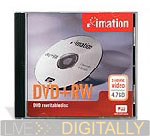 With my “closed” disc in hand, an Imation DVD+RW, 4x, I wanted to see how the quality of the write was. For computer DVDRW drives, we examine them using two types of tests. The first is using CD Speed, we subject them to a quality test, using a LiteOn drive. This serves to detect errors, and failures in the write process, and gives an overall indication of the writing quality of the drive. The second, is I attempt to play the disc in two different set top DVD players to verify readability. After all, what’s the best quality write if it can’t be viewed? Well, the Ilo wrote the discs, so let’s subject them to the same standards.
With my “closed” disc in hand, an Imation DVD+RW, 4x, I wanted to see how the quality of the write was. For computer DVDRW drives, we examine them using two types of tests. The first is using CD Speed, we subject them to a quality test, using a LiteOn drive. This serves to detect errors, and failures in the write process, and gives an overall indication of the writing quality of the drive. The second, is I attempt to play the disc in two different set top DVD players to verify readability. After all, what’s the best quality write if it can’t be viewed? Well, the Ilo wrote the discs, so let’s subject them to the same standards.
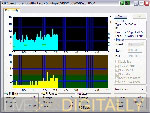 The first stop is Nero’s CD Speed Disc Quality Test. The rewritable disc was read in a LiteOn 852S drive at the standard 4x. The following scan was generated for a 4x DVDRW disc. The disc was written in the Ilo for one hour at the 2 hour speed.
The first stop is Nero’s CD Speed Disc Quality Test. The rewritable disc was read in a LiteOn 852S drive at the standard 4x. The following scan was generated for a 4x DVDRW disc. The disc was written in the Ilo for one hour at the 2 hour speed.
By computer DVDRW writing standards, I would characterize that as an average write. Honestly, I was bracing myself for a dismal result, and was pleasantly surprised. The PI Errors (in blue) were quite low, and are clearly above average in quality, especially for a rewritable disc. The PI Failures (in yellow) are average, with 2 peaks at 5, where 4 is the cutoff. I would characterize that as about average as an isolated spike or two usually doesn’t affect playability. Therefore, for a rewritable disc that is more error prone, I think this was a good result.
Next the disc was tested for playability in two set top recorders. The disc played in the first time in both the Sharp and Sony DVD players. This was also great, as I have caught discs that cannot play in one or both of these machines, even with a decent disc scan. In summary, the discs recorded with the Ilo should play in a wide variety of devices, with a minimal number of issues
 A Ritek 8x DVD+R disc was next examined. This is a high quality disc that I have had great results with using computer DVD recorders. The Ilo wrote the disc at the 3 hour speed, and the disc had 2’40” of video on it. I scanned the disc at 4x using CD Speed with the following result.
A Ritek 8x DVD+R disc was next examined. This is a high quality disc that I have had great results with using computer DVD recorders. The Ilo wrote the disc at the 3 hour speed, and the disc had 2’40” of video on it. I scanned the disc at 4x using CD Speed with the following result.
The write was average on the scan. The PI Errors max out at 149 (<280 is within specs). The more serious PI Failures are less than 4, except for two spikes, the higher one is only 9. The disc played back on both DVD players without difficulty. Furthermore, on a CD Speed read test, the disc could be read with a smooth curve, and no restarts or stutters, and at full speed. This indicates an average quality write as well.
Summing up the strong & weak points…
Strengths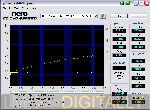
– low price
– uses more common “plus” media of the DVD Alliance
– compact size
– plays back MP3’s, WMA’s, and JPG’s
– average writing quality
– progressive scanning
Weaknesses
– watch battery in remote
– erratic clock setting behavior
– needs both coaxial and RCA inputs into television
– tiny buttons on remote control
– buttons on remote all lined up, impossible to use in dark
– tech support is nonexistent
– no in machine editing
– no optical ouptut
Who should buy this?
The budget videophile is the target audience for this machine. If you need to replace an aging VCR with something less than $100, this is your best (and currently only) choice. You can dabble in DVD recording for a minimal start up cost. At this price, it also makes a great second recorder for a household. Yes, a recorder with a hard drive built in will be better, but it will be a year or two before it is in this price range.
In Conclusion
The final verdict is that I’ll keep the Ilo. For the affordable price, it does what I need it to do. More than once though, I thought about scooping up a $35 VCR and just giving up on this whole DVD recording thing. For years, computer optical drive users have endured issues with every new drive, and new media in terms of compatibility. In the last year, things have improved, and more drives are less picky about the discs they will write to. I think that these set top DVD recorders will need a year or two of maturing while these compatibility issues get resolved.
For the budget user, looking to replace their VCR, it is an acceptable choice. The write quality is average, and the machine is easy to program and use. I also like that it can play MP3/WMA music files, and JPG pictures adding to the functionality of the device. Hopefully, others will benefit from my experience. It took me two months from the time the VCR broke until I had the Ilo up and running. For DVD Recorders to become a mainstream household electronic device, these compatibility issues need to be resolved. I doubt most users are willing to invest that much time into such a device. These compatibility issues also account for why there are so many boxes in the store that have been returned.
Ilo link for further information.
Special thanks to Ritek for providing media for this review.
Excellent review! Very thorough and informative! Good work! Very helpful in my DVD recorder evaluation process …
I appreciate your detailed review, as it has already saved me money (buying the wrong media). Later! Spike
thanks,nice to get a solid opinion before making a purchase,(for us electronic challanged)
Second one in a month.Units will not record or play 5.1 DTS audio. Burned VHS home movies(2) from VCR okay.Recorded two shows off HDNET and they skip every few seconds on four different players that I own. Used digital matrix dvd+r and Memorex dvd+r media. These units are no good at all except for coping VHS tapes it seems. Customer service is USELESS !!
These units are terrible……..will not play 5.1 dts audio or record 5.1. Customer service sucks and discs will not play in four different players that I own. They skip and freeze with two different type of media that I have used. MEMOREX DVD+R, DIGITAL MATRIX DVD+R
Great review. It really helped me to understand this product limitations. I bought it 1 week ago and I am really happy with it. There was around 30 boxes at my Wal Mart and I have selected the most recent MU unit (the manufacturing date is on the side of the box on a sticker. Most of them were June 2005 and I found a August 2005). I also bought the right media and everything is working fine up to know. Thanks again
Absolutely agree with the review. Lots of high end features, but not very user friendly.
Unfortunately, I found this review after four failed attempts to format. The manual says 20-45 seconds… after 4 minutes (each) I received “Disc Error” using two Memorex +R 8x and two Imation +R 8x… so, I guess it’s back to WallyWorld for a pack of +RW 4x… The upside: the cashier made sure the discs I picked up were +R. In any case, many thanks to Jonas! We’ll find out tomorrow if he’s a lifesaver.
Re:#7
Maxell +RW 4x worked like a champ. Now, is it the +RW and/or the 4x?? That is the question…
Anybody else have go/no go feedback on blank media?
I used both Imation 8x-R and 8x+R with no problem…At first. I got 6 burns with the -R before it saw them as incompatibl; strangely it will format them & burn, it just won’t finish them, all this without a firmware update. I just downloaded the firmware updates & am going to burn themto CD-R then update the firmware.
After I am going back to wally world to get some 4x +R imations, to see if it still works. If not I’ll RMA it, I just which I had run across this before I used those -R’s in it!
Thank you all for your support. If we post our media experiences, it will help to keep track of which discs work and don’t with the unit. I recently took a trip, and had the recorder set up to record some of my favorite programs. It was great to be able to access them in the order I wanted, rather than with a VCR where it can be difficult to access number 3 of 6 recorded programs!
I bought the DVDR-05 a few days ago and been recording like mad. The picture seems a little blotchy on any source, tuner, video1, and S-Video. so much that recording between 2-4 hour speeds doesn’t make a difference. I use imation +RW. it seems that if i use chapter stops my pc has a hard time reading it, and a few things it recorded it wouldn’t read it at all.
Just to let everyone know, I mainly bought this machine to dump video from my DV camera to DVD. It actually surprise me at how easy it was and how well it did it. I used Verbatim 16x +r bulk from Sam’s. Played great on my Panasonic 5 disc DVD player. Firewire works for input only.
Jason: What type of drive are you using to read your discs? A DVD writer is generally more tolerant than many of the DVD-ROM drives.
Ilo DVDR50 seemed ok at first when recording a tv show, but the playback sound track of the DVD+R on the Ilo and a Sony DVD player was marginaly distorted. While the voices seemed ok, the musical sound track seemed slow/warped
sounding. Very annoying. The same problem showed up on the show and commercials and was NOT in present when watching it live.
Can you manually setup ‘chapters’ with this unit?
good review, but, my understanding that with +rw, not necessary to formatt or finalize disc. just put in and use, take out when done. my unit deletes very quickly.
In response to John (#16): You can use a +RW only in the Ilo unit as you describe. You must format any disc for the unit to be able to write to it, just like a hard drive has to be formatted to be used. If you want to watch a recorded show in another DVD player, you need to finalize the disc first. This includes playback even in recordable DVD drives as well in my experience.
We bought an ilo DVDR05 using Memorex DVD+RW media. Recording from a DV tape. First time out of the box, it recorded fine. Second time, it recorded for 2minutes 26 seconds and completely froze up. Couldn’t shut down the unit except by unplugging it.
Repeated attempts also failed the same way. Any thoughts? Could it be the media I’m using? The discs formatted OK. Any info will be appreciated.
I was very please using ilo dvd05r. It was more then I expected. Great Feature to display all input video Signals to Component Video output.
Richard (#18): Here are my thoughts.
#1- The disc may be bad. See if you can check it in a computer DVDRW drive by trying to format it.
#2- the other day, I had two of the Memorex DVD+RW discs that the Ilo had previously recorded to. The Ilo wouldn’t recognize them, and kept spitting them out at me. I took the discs, in my DVDRW drive, I did a full blanking session using Nero. The discs now work fine in the Ilo player. I suspect that the discs will need to be “rejuvenated” periodically in this fashion.
can this dvd recorder take shows in live time and record them to a disk and do that every time it comes on like tivo does?
I’ve read on another site that the ILO DVDR doesn’t allow you to view the program once you’re recording. Seems ridiculous but is there any truth to it???
Appreciate the great review, going to buy one this week.
Thanks!
Can you use this dvd05 recorder as a dvd player to watch movies?
Try using Taiyo Yuden 4x or 8x +R disks. I’ve had NO failures since using these fine disks.Maxell,Memorex,Ritek,and some others all had some failures
I have ilo 5 & 4. usuall pretty good..but can be tempermantal. If you have put labels on your discs, remove them using
De-Solv-it.
Just to clarify, the Ilo will play back DVD movies. It can record, but you need to manually program the date and time like on a VCR. It is not a TIVO unit. Then again, there’s no monthly fee.
Has anybody checked to see whether the TUNER section of this machine provides the TV audio in stereo? Many of the cheaper DVRs only provide mono, i.e. identical signals to the L & R channels. Kinda like those super-cheap mini FM radios.
This thing sucks. My hubby and i got one right before Christmas for our new tv room. We watched 2 movies and now it won’t play. It says “loading” then “reading” across the front display, makes a bunch of zapping noise like it really is trying to read something it doesn’t understand then just stops. I hate it. I would return it or contact the company but have had no luck finding my paperwork. Thinking the husband threw it in the square file never to be seen again. Out the $100.00 for the ilo recorder PLUS another $90.00 for the camera we have so we could record to disc. Any suggestions?
will another remote work on the ilo? If so.. what kind, and what are the codes? I need help.
Good review. I was wondering if anyone has had any experience with Magnavox MRB660 and Philips DVDR615.
I have got the DVDR615 myself, and I think it is a great device. The sound and image quality is great!
More info:
http://www.consumer.philips.com/dvdrecorders
More reviews:
http://reviews.designtechnica.com/review1720.html
Hope this will help you.
Great review. I purchased one of these units about 5 months ago. The unit performed well for 1 day before it quit. I exchanged the unit for a second one the next day. There was no hassel at all at Wal-Mart getting the exchange. The second unit has more than met my expectations. There are a few things I have found out about my unit that I will pass on to you.
1. Don’t use DVD+R disks unless you plan to use the disks only on the ilo it was burned on. I have 3 DVD players in other rooms and none of them will make it through an entire recorded and finalized DVD+R disk without locking up. DVD+RW disks play on all of these players with no problems.
2. The 4 hour mode works well for recording TV programs. Anything over 4 hours degrades too much and the 8 hour mode is not acceptable.
3. DON’T FILL UP THE DISK!!!!! If you are using the 4 hour mode, leave at least 30 minutes of free space on the disk or you may loose everything you have recorded. As with a lot of burners on PC’s the machine requires some space on the disk to store information your player needs to know what is on the disk. If you fill up the disk and the player does not have enough room to write this information to the disk, you will probably loose everything on the disk. I have tried this several times and it does happen – at least on my unit.
4. When you finish recording a program, be sure to protect the program before you remove the disk. If you don’t protect the program you recorded you will loose it when you remove the disk – at least this happens on my unit. You may also loose the disk if it’s a DVD+R.
5. The battery life on the remote seems to be acceptable. I have been using the unit I have for about 5 months and I still have the same battery in it. The unit is used every day for recording or for playing back something.
6. One really great feature my unit has is the ability to play back .jpeg pictures and MP3 music files at the same time like a slide show. I have loaded up to 150 pictures and several MP3 songs on one CD-RW disk and once inserted in the ilo unit, and after a trip through the menu that pops up, the unit will show the pictures and play the music at the same time – and the pictures will auto index about every 6 seconds. I am very pleased with this feature! Its just like a slide show without all of the setup time on a PC.
I hope this information will be helpful.
Need help. Just got the ilo dvdro5 for my birthday today and can’t get it to work at all. I have direct tv and can’t seem to get it configured right with the cables. The instructions only show how to hook up through dvd to vcr to tv. Can anyone help?
Hi ,I just purcased a ILO DVDRO5. It seems to record and play fine ,but I cant get it to record over 1 hour.The manual says choose TIMEDREC OFF if you dont want to specify a recording length.I cant find this setting. Does anyone out there know where it is and how to get to it? thanks James
I cannot get my recorder to scan the channels from my satellite receiver. Almost the same problem Fernie said on the above post. The only one I get is the one I am watching on the receiver and it comes on in channel three of the recorder. Can someone tell me what I am doing wrong.My unit is DVDR05ZU if that makes a difference. No upgrade yet to receiver.The connections are: Coaxial connection from the Satellite receiver to the recorder(in Ant) and coaxial cable from recorder(out) to tv. RCA output from recorder to TV.
James: Hit the record button – you will see in the top right hand corner of the screen that each time you hit record, it will change the recording time to 30, 60, 90 minutes etc. Keep hitting until you see “Time Rec Off.” This should fix your prob.